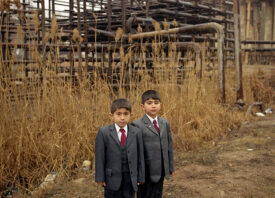Search this site
Powerful Photos of the Body After Death


When photographer Patrik Budenz first requested permission to document the work at Berlin’s Institute of Legal Medicine and Forensic Sciences in 2007, the answer was
no. When he wrote a proposal to the head of the institute, he was told to wait two weeks for a response. Twenty minutes later, he got the phone call. He was invited to bring his camera into the autopsy room, labs, and after some time, onto crime scenes.Before he set foot in the Institute, Budenz had never been around death, with the exception of his grandparents, who passed away when he was too little to process what had happened. He admits to being nervous prior to those first visits, but the professionals calmly walked him through the autopsy process.
Budenz has now been dealing on and off with the forensic aspects of crime, medicine, and death for almost a decade, beginning with his documentary series Search for Evidence. He’s become accustomed to the things that used to frighten him, like the cracking sound the ribs make when they’re opened. His book Post Mortem, now in its second edition, is a step-by-step chronicle of the process that follows after a heart stops beating.
He started directly after the body leaves a hospital or a crime scene, moved forward to the labs and the crematorium, then to the undertakers.
All the bodies in Post Mortem are kept unidentified, though Budenz was able to overhear bits and pieces of their stories, including the age and cause of death of the deceased. The personal details, he says, were often the hardest part.
He struggled most with young people who had been killed by disease or accident. When asked whether he’s mourned for any of the strangers whose bodies he’s photographed, Budenz says “mourning” is too strong a word, but yes, he does get sad.
Though the professionals encouraged the photographer not to take the work home with him, the people he’d seen did sometimes follow.
He confided in his girlfriend without revealing anything confidential. “If you were really alone with this, I can imagine it would be hard,” he admits, “I was lucky to have someone to talk to.”
Still, coming into contact with the technical details of death hasn’t made him more afraid. In some ways, it’s been a comfort to him. In Western culture, he suggests, we keep death hidden from view, and that’s what makes it frightening.
He’s had people tell him they’re afraid of feeling pain when they’re dead. They are worried someone might make a mistake and cremate or bury them alive, but seeing it firsthand, Budenz can assure them this never happens. When you die, you’re left in good hands.
He’s no longer nervous to arrive at an autopsy. He feels safe: “People don’t want to deal with it, but if you get to know it a little bit more, it can be less scary.”
Budenz isn’t a religious person. He thinks that once someone dies, he or she stops existing. “The idea that my soul dies with my body is something that doesn’t scare me,” the photographer says, “Life is over, and that’s how it’s supposed to be. I can sleep knowing that.”
Since the original publication of the images eight years ago, the photographer estimates he receives anywhere from two to five emails from a grieving stranger per year. One of them, from a woman who had lost her grandfather, is included as the only text in the book. She told him that after seeing the pictures, for the first time since the death, she was able to sleep alone.
He responds to every single letter like this one: “If people write something like this, I have to respond. They give me something very personal. I can’t ignore it.”
Occasionally, he flips back through the book when he has free time. “Sometimes, I have the feeling I have to look at them,” he says.
Budenz does understand why people would want to take refuge in the idea of the afterlife, but for him personally, the most meaningful thing to be found in death is what it tells us about being alive. “You see how fast a life can end,” he says, “and you really start to value things a little bit more.”
Post Mortem is available on Amazon and via the photo-eye bookstore.








All images © Patrik Budenz



